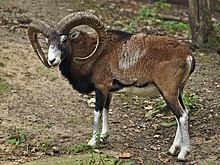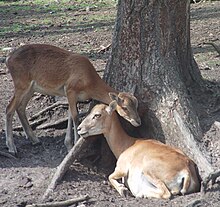Mouflon

Several species of wild sheep are grouped together as mouflon ( Ovis gmelini group) . In a narrower sense, it refers to a single subspecies, the European mouflon . It is controversial whether the mouflon, as wild sheep, is the ancestor of the domestic sheep or a feral descendant of very original domestic sheep.
The gender of the word "mouflon" is usually given in dictionaries as masculine, sometimes also as a neuter. The Romanic Etyma ( French mouflon < Italian muflone, perhaps via Sardinian - Corsican muvrone, mufrone ) of the loan word are masculine.
features
Mouflons have a head-trunk length of 130 centimeters and a body height of 90 centimeters. Aries (male mouflons) usually weigh 50 kilograms, while sheep (females) weigh 35 kilograms.
habitat
The habitat of the mouflon are mountainous landscapes. Here females form flocks of up to a hundred animals with one, sometimes two lambs , while the bucks only join the flocks during the mating season . In their naturalization areas, on the other hand, they are mainly characterized by the fact that they are mainly in the forest. Agricultural areas close to the forest are only visited at certain times of the day and year. Seasonal vertical migrations occur in the original habitat as well as in the regions where mouflons were naturalized.
Mouflons are true animals; the mother family associations have occupied traditional territories for generations. Exact knowledge of their respective habitat is an essential part of their enemy avoidance strategies. When wolves, which are among the most important predators of the mouflon, approach, the mother tries to reach cliffy terrain with the lamb. As a rule, the wolf cannot follow her there. The lambs are also endangered by eagles and mother animals seek cover-rich terrain with their lambs when the birds of prey appear in the sky. Mouflons rarely colonize new territories.
Mouflons orient themselves in their area of action on conspicuous terrain features, changes of location take place by running one behind the other in a long row. Clearly visible changes can therefore be made out in mouflon territories. It is typical of their behavior that they use elevations in the terrain to get an overview.
distribution
Today the mouflon is common in the Caucasus , Anatolia , northern Iraq and northwestern Iran . Once its distribution area extended over the Crimea and the Balkans to the Carpathian Mountains. In these areas, however, it disappeared as early as the Bronze Age (around 3000 years ago) or even earlier. In addition, mouflons live on Elba , Cyprus , Corsica and Sardinia ; However, it is controversial whether these are wild sheep or descendants of very original domestic sheep. In many areas of Europe the mouflon has recently been released into the wild as a hunt .
species
Colin Peter Groves and Peter Grubb (2011) distinguish three types of mouflon:
- Armenian mouflon ( Ovis gmelini Blyth, 1841 ): South Caucasus region in Armenia and Nakhchivan , northwest Iran and southern and eastern parts of Asia Minor . The shoulder height is 88 to 94 cm, the horns are curved backwards in a negative helical shape, the horn length is up to 67 cm, the circumference of the horns at the base is between 22 and 27 cm. Females are partially polled. The fur color varies between rust-red and cinnamon-colored, with the males there is usually a light flank patch of variable size on the sides. The chest and underside are characterized by elongated, dark hairs that do not, however, extend to the throat. Since the nomenclature status of Ovis orientalis is controversial, the younger synonym Ovis gmelini is now used. Sometimes the Anatolian form of the mouflon, of which around 2000 animals still live in a protected area in southern Turkey near Konya , is separated from the Armenian mouflon as a separate subspecies ( Ovis gmelini anatolica ).
- Isfahan mouflon ( Ovis isphahanica Nasonov, 1910 ): Zagros Mountains in Iran.
- Laristan mouflon ( Ovis laristanica Nasonov, 1909 ): The Laristan mouflon is small. Adult bucks hardly reach more than 34–35 kg body weight. The distribution area is limited to a few reserves near the city of Lar in southern Iran. The habitat are hot desert areas .
In older systems such as Grubb 2005, the Isfahan mouflon and the Laristan mouflon are still considered subspecies of the Armenian wild sheep (under the name Ovis aries , an alternative name for the domestic sheep). The following forms are partially recognized as further subspecies of the Armenian wild sheep:
- European mouflon ( Ovis gmelini musimon ( Pallas, 1811 )): Around the fifth millennium BC. The European mouflon came to Corsica and Sardinia, and was introduced to almost all of Europe .
- Cyprus mouflon ( Ovis gmelini ophion Blyth, 1841 ): The Cyprus mouflon was almost extinct in the course of the 20th century, but has since been brought to a population of 2000 through protective measures. According to estimates from 1997, the population has fallen to 1200 as a result of diseases , which is why the subspecies is highly endangered.
- Domestic sheep ( Ovis gmelini aries Linnaeus, 1758 ).
Relationship with people
The mouflon was domesticated an estimated 10,000 to 11,000 years ago, making it one of the oldest domesticated species after the dog. Since then there have been domestic sheep . Anatolia is considered to be the most likely place of first domestication . According to genetic data, the common subspecies Ovis gmelini anatolica is the ancestral form of all domestic sheep.
Heraldic animal
The mouflon is of great importance on the island of Cyprus. The mouflon can be found on the cent coins of the old currency, the Cyprus pound, as well as on the new 1, 2 and 5 cent coins of the euro .
The national airline of Cyprus, Cyprus Airways , wore a winged mouflon as a logo on the tail units of its aircraft from the 1960s until its dissolution in 2015.
Individual evidence
- ↑ See the entries in Duden and the dictionary of contemporary German .
- ↑ See the entry “mouflon” in the Trésor de la langue française informatisé and the entry of the same name in the English Wiktionary.
- ↑ Haseder, p. 547 (reproduction)
- ↑ Piegert et al., P. 15
- ↑ a b Piegert et al., P. 14
- ↑ Colin P. Groves, David M. Leslie Jr .: Family Bovidae (Hollow-horned Ruminants). In: Don E. Wilson and Russell A. Mittermeier (eds.): Handbook of the Mammals of the World. Volume 2: Hooved Mammals. Lynx Edicions, Barcelona 2011, ISBN 978-84-96553-77-4 , pp. 727-728
- ↑ Colin Groves, Peter Grubb: Ungulate Taxonomy. Johns Hopkins University Press, 2011, pp. 1-317 (pp. 234-235)
- ↑ Shackleton, D., M., (ed.) And the IUCN / SSC Caprinae Specialist Group, 1997. Wild Sheep and Goats and their Relatives. Status Survey and Conservation Action Plan for Caprinae. IUCN, Gland, Switzerland and Cambridge, UK. P. 139
- ^ Peter Grubb: Order Artiodactyla . In: Don E. Wilson, DeeAnn M. Reeder (Eds.): Mammal Species of the World . A Taxonomic and Geographic Reference . 3. Edition. Johns Hopkins University Press, Baltimore 2005, ISBN 0-8018-8221-4 , pp. 637-722 (pp. 708-710).
- ^ Melinda A. Zeder (2011): The Origins of Agriculture in the Near East . Current Anthropology 52, Supplement 4: pp. 221-235.
- ^ Benjamin S. Arbuckle, Levent Atici: Initial diversity in sheep and goat management in Neolithic south-western Asia . In: Levant . tape 45 , no. 2 , November 2013, p. 219-235 , doi : 10.1179 / 0075891413Z.00000000026 .
- ↑ Sevgin Demirci, Evren Koban Baştanlar, Nihan Dilşad Dağtaş, Evangelia Pişkin, Atilla Engin, Füsun Özer, Eren Yüncü, Şükrü Anıl Doğan, İnci Togan (2013): Mitochondrial DNA Diversity of Modern, Ancient and Wild Sheep (Oatol gmelini )i from an Turkey: New Insights on the Evolutionary History of Sheep. PLoS ONE 8 (12): e81952. doi : 10.1371 / journal.pone.0081952
literature
- Colin P. Groves, Peter Grubb: Ungulate Taxonomy. Johns Hopkins University Press, 2011, pp. 1-317 (pp. 234-235).
- Colin P. Groves, David M. Leslie Jr .: Family Bovidae (Hollow-horned Ruminants). In: Don E. Wilson and Russell A. Mittermeier (eds.): Handbook of the Mammals of the World. Volume 2: Hooved Mammals. Lynx Edicions, Barcelona 2011, ISBN 978-84-96553-77-4 , pp. 727-728.
- VG Heptner: Mammals of the Soviet Union. Volume 1: Ungulates. Leiden and New York 1989, ISBN 90-04-08874-1 .
- Holger Piegert, Walter Uloth: The European mouflon. DSV-Verlag, Hamburg 2005, ISBN 3-88412-429-3 .
- Ilse Haseder, Gerhard Stinglwagner: Knaur's large hunting dictionary. Augsburg 2000, keyword: Muffelwild, p. 545, ISBN 3-8289-1579-5 .


